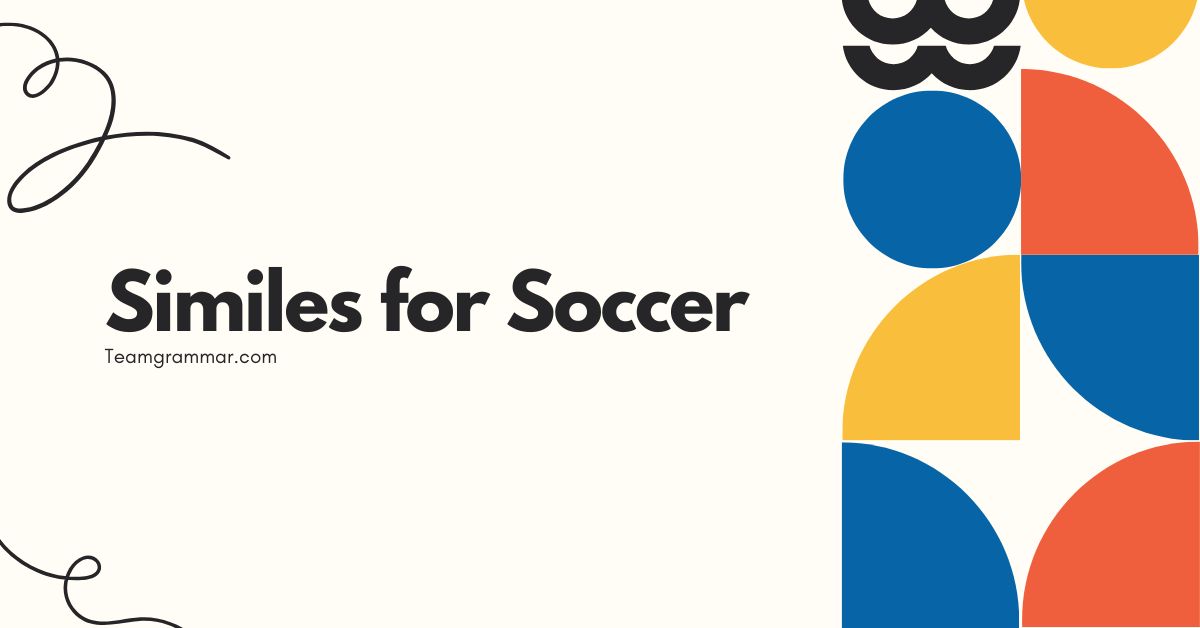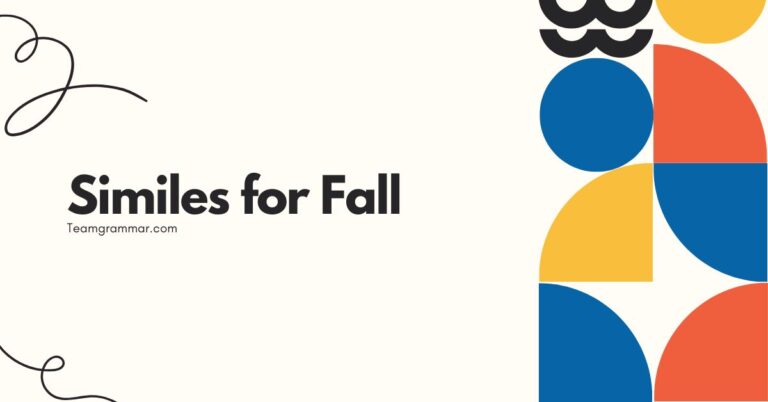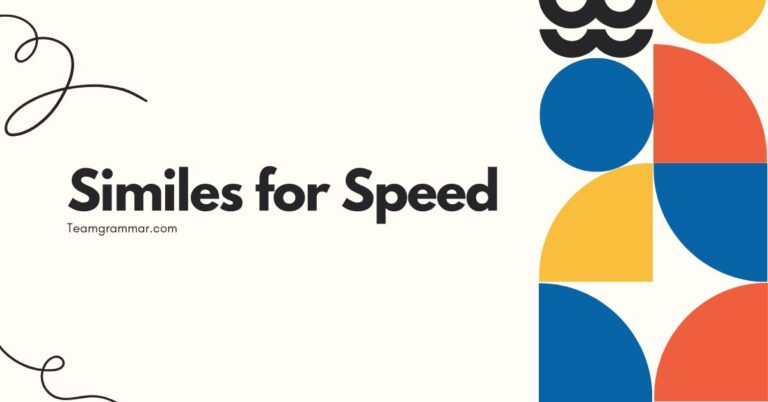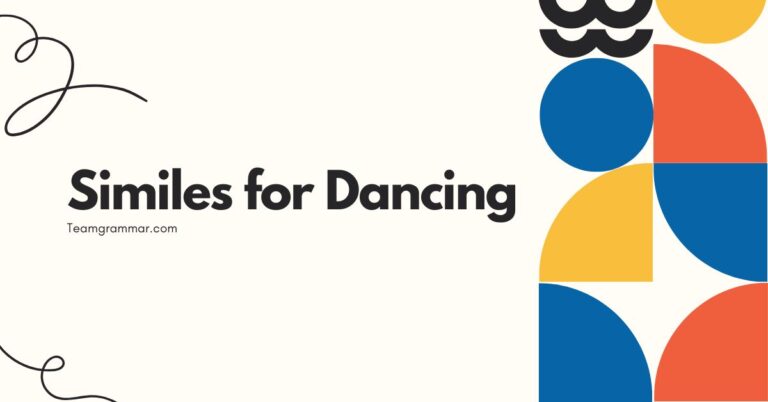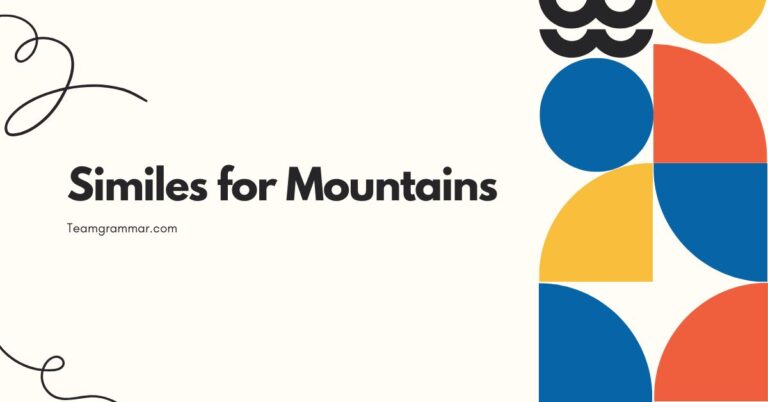43 Similes for Soccer: Enhancing Your English Vocabulary
Understanding similes is crucial for mastering figurative language and enriching your vocabulary. Similes, a cornerstone of English grammar, allow us to draw comparisons between seemingly unrelated things, adding depth and color to our descriptions.
This article focuses on similes related to soccer, offering a fun and engaging way to learn and apply this grammatical concept. Whether you’re an English language learner, a soccer enthusiast, or simply looking to improve your writing skills, this guide will equip you with the knowledge and examples you need to confidently use similes in your everyday communication.
By exploring similes specifically related to soccer, we can appreciate how language can be used creatively to describe the speed, skill, and intensity of the game. This approach not only enhances your understanding of similes but also expands your vocabulary and improves your ability to express yourself vividly.
Get ready to dive into the world of soccer-themed similes and discover how they can transform your writing and speaking!
Table of Contents
- Definition of a Simile
- Structural Breakdown of Similes
- Types of Similes
- Examples of Similes for Soccer
- Usage Rules for Similes
- Common Mistakes with Similes
- Practice Exercises
- Advanced Topics in Similes
- Frequently Asked Questions
- Conclusion
Definition of a Simile
A simile is a figure of speech that directly compares two different things using the words “like” or “as.” The primary function of a simile is to create a vivid image or to emphasize a particular quality by associating it with something familiar. Similes are a powerful tool in both writing and speech, adding color, depth, and clarity to communication.
In essence, a simile asserts that one thing shares a characteristic with another, thereby enhancing the reader’s or listener’s understanding. This comparison helps to illustrate a point more effectively than a simple statement of fact.
For example, instead of saying “The soccer player was fast,” a simile might say, “The soccer player was as fast as a cheetah,” creating a much stronger and more memorable image.
Classification of Similes
Similes are classified as a type of figurative language, specifically belonging to the broader category of comparisons. Figurative language uses words or expressions with a meaning that is different from the literal interpretation.
Similes, along with metaphors, personification, and hyperbole, are all examples of how language can be used creatively to convey meaning.
Within the realm of comparisons, similes are distinct from metaphors. While both draw comparisons, similes do so explicitly using “like” or “as,” whereas metaphors imply the comparison without these words.
Understanding this distinction is crucial for effectively using both figures of speech.
Function of Similes
The main function of a simile is to enhance understanding and create a more vivid image in the mind of the reader or listener. By comparing something unfamiliar to something familiar, similes help to make abstract concepts more concrete and relatable.
This can be particularly useful in descriptive writing, where the goal is to paint a picture with words.
Furthermore, similes can be used to add emphasis or humor to a statement. A well-crafted simile can make a point more memorable and engaging, capturing the audience’s attention and leaving a lasting impression.
In the context of soccer, similes can be used to describe the speed of a player, the power of a shot, or the intensity of a match.
Contexts for Using Similes
Similes are used in a wide variety of contexts, from literature and poetry to everyday conversation. They are particularly common in descriptive writing, where they help to create a more vivid and engaging reading experience.
Similes are also frequently used in advertising and marketing to make products more appealing and memorable.
In the context of sports, similes can be used to describe the performance of athletes, the strategies employed by teams, or the overall atmosphere of a game. Whether you’re writing a sports report, giving a commentary, or simply discussing a match with friends, similes can add color and excitement to your language.
Structural Breakdown of Similes
Similes have a straightforward structure, typically consisting of three key elements: the subject being compared, the word “like” or “as,” and the object to which the subject is being compared. Understanding these elements is essential for constructing effective and grammatically correct similes.
The basic formula for a simile is:Subject + “like” or “as” + Object. This structure provides a clear and direct comparison, making it easy for the audience to understand the intended meaning.
Let’s break down each element in more detail.
The Subject
The subject of a simile is the thing being described or compared. It can be a noun, a pronoun, or a noun phrase.
The subject is the focal point of the comparison, and it is the quality or characteristic of the subject that the simile aims to highlight. For example, in the simile “The soccer ball was like a bullet,” the subject is “the soccer ball.”
Choosing a strong and relevant subject is crucial for creating an effective simile. The subject should be something that the audience can easily relate to and understand.
In the context of soccer, the subject might be a player, a ball, a goal, or even the entire game itself.
The Comparison Word: “Like” or “As”
The words “like” and “as” are the essential components that identify a statement as a simile. They serve as the bridge connecting the subject and the object of the comparison.
While both words can be used interchangeably in many cases, there are subtle differences in their usage.
“Like”is generally used when the comparison is more general or approximate. For example, “He runs like the wind” suggests that he is fast, but not necessarily as fast as the wind itself.”As”is often used when the comparison is more specific or direct.
For example, “He is as strong as an ox” implies a more precise level of strength.
The Object
The object of a simile is the thing to which the subject is being compared. It should be something that is familiar to the audience and possesses the quality or characteristic that the simile is trying to emphasize.
In the simile “The soccer ball was like a bullet,” the object is “a bullet.”
Choosing an appropriate object is crucial for creating a meaningful and effective simile. The object should have a clear and recognizable association with the quality being described.
In the context of soccer, the object might be a cheetah to describe speed, a wall to describe defense, or a magnet to describe ball control.
Types of Similes
While all similes share the same basic structure, they can be categorized based on the type of comparison they make. Understanding these different types can help you to craft more nuanced and effective similes.
Similes can be broadly classified into descriptive similes, emphatic similes, and ironic similes. Each type serves a different purpose and can be used in different contexts to achieve a specific effect.
Descriptive Similes
Descriptive similes are used to provide a vivid and detailed description of something by comparing it to something else. These similes aim to create a clear image in the mind of the reader or listener, helping them to visualize the subject more effectively.
Descriptive similes are common in literature, poetry, and descriptive writing.
For example, “The stadium was as loud as a roaring ocean” is a descriptive simile that helps to convey the immense noise and energy of the stadium. This type of simile focuses on creating a sensory experience for the audience.
Emphatic Similes
Emphatic similes are used to emphasize a particular quality or characteristic of something by comparing it to something that is known to possess that quality to a high degree. These similes aim to strengthen the impact of a statement and make it more memorable.
Emphatic similes are often used in persuasive writing and public speaking.
For example, “He is as determined as a lion hunting its prey” is an emphatic simile that highlights the player’s unwavering determination. This type of simile focuses on reinforcing a specific attribute.
Ironic Similes
Ironic similes are used to convey a meaning that is the opposite of the literal meaning of the words. These similes often involve comparing something to something that is known to be ineffective or undesirable, creating a humorous or sarcastic effect.
Ironic similes are common in satire and comedy.
For example, “He’s about as useful as a screen door on a submarine” is an ironic simile that suggests the person is completely useless. This type of simile relies on the audience’s understanding of the implied contrast.
Examples of Similes for Soccer
Here are some examples of similes related to soccer, categorized by the aspect of the game they describe. These examples illustrate how similes can be used to add color and depth to your descriptions of soccer-related events, players, and strategies.
We will explore similes related to player attributes, ball movement, game atmosphere, and strategic plays, providing a comprehensive overview of how similes can be used in the context of soccer.
Similes Describing Player Attributes
These similes describe the physical and mental attributes of soccer players, such as their speed, strength, agility, and skill.
Below is a table with 30 examples of similes describing player attributes:
| Simile | Explanation |
|---|---|
| He was as fast as a cheetah on the field. | Describes the player’s exceptional speed. |
| She moved through the defense like a hot knife through butter. | Describes the player’s agility and ease in bypassing defenders. |
| His shot was as powerful as a cannon. | Describes the force and strength of the player’s shot. |
| He was as agile as a cat, dodging tackles with ease. | Describes the player’s nimbleness and ability to avoid challenges. |
| Her passes were as precise as a surgeon’s cut. | Describes the accuracy and precision of the player’s passes. |
| He defended like a wall, blocking every shot. | Describes the player’s strong and impenetrable defense. |
| She was as quick as a hummingbird, darting around the field. | Describes the player’s rapid and unpredictable movements. |
| His tackles were as fierce as a lion’s bite. | Describes the intensity and aggression of the player’s tackles. |
| He was as calm as a monk under pressure. | Describes the player’s composure and ability to stay calm in stressful situations. |
| She was as graceful as a swan, gliding across the pitch. | Describes the player’s elegance and fluidity of movement. |
| His vision was as sharp as an eagle’s, spotting every opportunity. | Describes the player’s excellent awareness and ability to see openings. |
| She was as relentless as a machine, never stopping her runs. | Describes the player’s tireless effort and endurance. |
| His headers were as accurate as guided missiles. | Describes the precision and power of the player’s headers. |
| He was as solid as a rock in midfield. | Describes the player’s stability and reliability in the center of the field. |
| She was as creative as an artist, crafting beautiful plays. | Describes the player’s ingenuity and ability to create scoring opportunities. |
| His control was like glue, the ball stuck to his feet. | Describes the player’s exceptional ball control. |
| He was as strong as an ox, pushing through challenges. | Describes the player’s immense physical strength. |
| She was as cunning as a fox, outsmarting her opponents. | Describes the player’s cleverness and tactical intelligence. |
| His reflexes were as quick as a snake’s strike. | Describes the player’s rapid reactions and agility. |
| He was as tenacious as a bulldog, never giving up the chase. | Describes the player’s persistence and determination. |
| She was as light as a feather on her feet. | Describes the player’s graceful and effortless movement. |
| His passes were as smooth as silk. | Describes the fluidity and ease of the player’s passes. |
| He was as hungry as a wolf for the ball. | Describes the player’s intense desire and motivation. |
| She was as deceptive as a magician with her footwork. | Describes the player’s skill at fooling opponents with their movements. |
| His presence was as commanding as a general. | Describes the player’s leadership and influence on the field. |
| He was as cool as a cucumber in front of goal. | Describes the player’s composure under pressure when scoring. |
| She was as fiery as a dragon, intimidating her opponents. | Describes the player’s intense and intimidating presence. |
| His shots were as unpredictable as a wild card. | Describes the player’s ability to surprise the goalkeeper. |
| He was as steady as a clock, always consistent. | Describes the player’s reliability and consistency. |
| She was as quick-witted as a comedian on the field. | Describes the player’s ability to make smart decisions quickly. |
Similes Describing Ball Movement
These similes describe the movement of the soccer ball, such as its speed, trajectory, and spin.
Below is a table with 25 examples of similes describing ball movement:
| Simile | Explanation |
|---|---|
| The ball flew like a rocket towards the goal. | Describes the rapid speed and straight trajectory of the ball. |
| The pass was as smooth as a flowing river. | Describes the effortless and fluid movement of the ball. |
| The ball curved like a banana around the defender. | Describes the curved trajectory of the ball due to spin. |
| It bounced like a rubber ball on the hard surface. | Describes the erratic and unpredictable movement of the ball. |
| The ball floated like a feather in the air. | Describes the slow and gentle movement of the ball. |
| The ball stuck to his foot like glue. | Describes the player’s excellent ball control. |
| It swerved like a snake, deceiving the goalkeeper. | Describes the ball’s sudden and unexpected change of direction. |
| The ball traveled as fast as lightning across the field. | Describes the ball’s incredible speed. |
| It spun like a top, making it difficult to catch. | Describes the rapid rotation of the ball. |
| The ball arced like a rainbow over the defenders. | Describes the high, curved trajectory of the ball. |
| It rolled like a marble across the polished floor. | Describes the smooth and effortless movement of the ball. |
| The ball danced like a butterfly between the players. | Describes the light and graceful movement of the ball. |
| It zipped like a bullet past the outstretched hands of the goalie. | Describes the ball’s extreme speed as it enters the goal. |
| The ball bounced awkwardly like a kangaroo. | Describes the irregular and unpredictable bounce of the ball. |
| It moved as predictably as a train on its tracks. | Describes the consistent and expected path of the ball. |
| The ball looped over the wall like a tossed coin. | Describes the curving path of a free kick over the defensive wall. |
| It bobbed like a cork on water. | Describes the ball’s unstable movement. |
| The trajectory of the ball was as straight as an arrow. | Describes the direct and unwavering path of the ball. |
| It was passed from player to player as if connected by an invisible string. | Describes the seamless passing between teammates. |
| The ball floated into the net as gently as a snowflake. | Describes a softly placed shot that scores. |
| It was kicked with a force like a mule. | Describes the power behind the kick. |
| The ball sailed over the field as free as a bird. | Describes the unrestricted movement of the ball through the air. |
| Its movement was as fluid as water. | Describes the smooth and continuous motion of the ball. |
| The pass was as crisp as autumn air. | Describes a sharp and precise pass. |
| The ball was juggled as easily as a comedian juggles balls. | Describes the player’s adept juggling skills. |
Similes Describing Game Atmosphere
These similes describe the atmosphere and environment of a soccer game, such as the noise of the crowd, the intensity of the competition, and the overall excitement.
Here is a table with 20 examples of similes describing the game atmosphere:
| Simile | Explanation |
|---|---|
| The stadium was as loud as a roaring lion. | Describes the intense noise and energy of the crowd. |
| The tension was as thick as fog before the penalty shootout. | Describes the palpable sense of anticipation and anxiety. |
| The atmosphere was as electric as a lightning storm. | Describes the excitement and energy of the game. |
| The cheers were as deafening as a jet engine. | Describes the overwhelming volume of the crowd’s support. |
| The pressure was like a vise, squeezing the players. | Describes the intense pressure and stress on the players. |
| The excitement was as contagious as a yawn. | Describes how easily the enthusiasm spread through the crowd. |
| The game was as intense as a battle. | Describes the high level of competition and aggression. |
| The silence was as heavy as a tomb when they missed the penalty. | Describes the profound and oppressive silence after a missed opportunity. |
| The celebrations were as wild as a jungle party. | Describes the exuberant and unrestrained celebrations. |
| The tension was as palpable as a heartbeat in a silent room. | Describes the easily sensed tension during a critical moment. |
| The disappointment felt as bitter as medicine. | Describes the unpleasant feeling of defeat. |
| The victory was as sweet as honey. | Describes the pleasant feeling of winning. |
| The rain fell like tears from the sky. | Describes the somber and emotional atmosphere. |
| The stadium lights shone as bright as a thousand suns. | Describes the intense illumination of the field. |
| The rivalry was as fierce as a feud between families. | Describes the deep-seated animosity between the teams. |
| The hope was as fragile as glass. | Describes the delicate and easily shattered optimism. |
| The determination was as strong as steel. | Describes the unwavering resolve of the players. |
| The passion was as hot as fire. | Describes the intense enthusiasm and dedication of the fans and players. |
| The nerves were as frayed as old rope. | Describes the heightened anxiety and stress. |
| The atmosphere was as festive as a carnival. | Describes the joyous and celebratory mood. |
Similes Describing Strategic Plays
These similes describe the strategic plays and tactics used in soccer, such as formations, passing patterns, and defensive strategies.
Below is a table with 20 examples of similes describing strategic plays:
| Simile | Explanation |
|---|---|
| The defense was as organized as a military formation. | Describes the disciplined and structured defensive setup. |
| Their passing was as intricate as a spider’s web. | Describes the complex and interconnected passing patterns. |
| The counter-attack was as swift as a falcon’s dive. | Describes the rapid and decisive offensive move. |
| The formation was as solid as a fortress. | Describes the impenetrable and secure defensive structure. |
| Their strategy unfolded as smoothly as a well-rehearsed dance. | Describes the coordinated and seamless execution of the game plan. |
| The offside trap worked like a charm. | Describes the effectiveness of the offside trap tactic. |
| Their midfield play was as dominant as a king’s rule. | Describes the strong control and influence of the midfield players. |
| The attack came as suddenly as a thunderclap. | Describes the unexpected and forceful offensive surge. |
| Their teamwork was as seamless as a well-oiled machine. | Describes how well the team works together. |
| The long ball was as direct as a laser beam. | Describes the straight and precise trajectory of the long pass. |
| Their pressing was as relentless as a swarm of bees. | Describes the constant and intense pressure on the opposing team. |
| The game plan was as clear as a blueprint. | Describes the well-defined and easy-to-understand strategy. |
| Their defense was as impenetrable as a brick wall. | Describes the strong and effective defensive barrier. |
| The tactics were as subtle as a whisper. | Describes the nuanced and understated strategies. |
| Their control of the game was as complete as a puppet master’s. | Describes the total command and influence over the match. |
| The formation shifted as fluidly as water. | Describes the seamless and adaptable changes in the team’s structure. |
| Their defense was as tight as a drum. | Describes the compact and impenetrable defensive line. |
| The attack was as synchronized as a flock of birds. | Describes the coordinated and harmonious offensive movements. |
| Their strategy was as precise as a mathematical equation. | Describes the calculated and exact approach to the game. |
| The team moved together like a school of fish. | Describes the cohesive and unified movement of the players. |
Usage Rules for Similes
Using similes effectively requires adherence to certain grammatical and stylistic rules. These rules ensure that your similes are clear, meaningful, and appropriate for the context in which they are used.
We will cover the importance of clarity, relevance, originality, and consistency in using similes, as well as common pitfalls to avoid.
Clarity and Understanding
A good simile should be easy to understand. The comparison should be clear and the connection between the subject and the object should be obvious.
Avoid using obscure or overly complex objects in your similes, as this can confuse the audience and diminish the impact of your comparison.
For example, instead of saying “His dribbling was like a complex algorithm,” which might be confusing to some, you could say “His dribbling was like a dance, weaving through the defenders,” which is more accessible and easier to visualize.
Relevance and Appropriateness
The object of your simile should be relevant to the subject and appropriate for the context. The comparison should make sense and enhance the overall meaning of your statement.
Avoid using similes that are illogical or that clash with the tone of your writing or speech.
For example, in the context of soccer, comparing a player’s speed to a snail would be inappropriate and humorous, unless you are intentionally trying to create an ironic effect. A more relevant comparison would be “He was as slow as a snail,” used to humorously point out a player’s lack of speed.
Originality and Freshness
While some common similes are widely used and understood, striving for originality can make your writing or speech more engaging and memorable. Try to come up with fresh and creative comparisons that will capture the audience’s attention and leave a lasting impression.
Instead of using the cliché “He was as fast as lightning,” you could say “He accelerated like a sports car, leaving the defenders in his wake.” This simile is more original and creates a more vivid image.
Consistency and Tone
Ensure that your similes are consistent with the overall tone and style of your writing or speech. Avoid using similes that are too informal or humorous in a serious context, or vice versa.
Maintain a consistent tone throughout your communication to avoid confusing or alienating your audience.
For example, in a formal sports report, avoid using overly casual similes such as “He kicked the ball like a boss.” A more appropriate simile would be “He struck the ball with the force of a seasoned professional.”
Common Mistakes with Similes
Even experienced writers and speakers can make mistakes when using similes. Being aware of these common errors can help you to avoid them and use similes more effectively.
We will address common mistakes such as mixing metaphors and similes, using clichés, and creating illogical comparisons, providing examples of correct and incorrect usage.
Mixing Metaphors and Similes
One common mistake is to inadvertently mix metaphors and similes in the same sentence or phrase. This can create confusion and weaken the impact of your comparison.
Be sure to use either a simile or a metaphor, but not both at the same time.
Incorrect: “He was a rock in defense, like a fortress standing tall.” (Mixing a metaphor “a rock” with a simile “like a fortress”)
Correct: “He was like a rock in defense.” (Simile)
Correct: “He was a fortress in defense.” (Metaphor)
Using Clichés
Overusing clichés can make your writing or speech sound unoriginal and uninspired. While some common similes are acceptable, try to avoid relying too heavily on them.
Strive for fresh and creative comparisons that will set your writing apart.
Cliché: “He was as strong as an ox.”
Better: “He was as strong as a weightlifter, effortlessly pushing past defenders.”
Creating Illogical Comparisons
Ensure that the comparison you are making is logical and makes sense. Avoid using similes that are nonsensical or that do not have a clear connection between the subject and the object.
Incorrect: “The soccer ball was like a refrigerator.” (No logical connection)
Correct: “The soccer ball was like a magnet to his feet.” (Clear connection: ball control)
Practice Exercises
Test your understanding of similes with these practice exercises. Each exercise focuses on different aspects of simile usage, from identifying similes to creating your own.
These exercises include multiple-choice questions, sentence completion tasks, and creative writing prompts designed to reinforce your knowledge of similes.
Exercise 1: Identifying Similes
Identify the similes in the following sentences. Underline the simile and identify the subject and object of the comparison.
| Question | Answer |
|---|---|
| 1. The player moved like a shadow across the field. | like a shadow; Subject: player; Object: shadow |
| 2. His shot was as powerful as a thunderclap. | as powerful as a thunderclap; Subject: shot; Object: thunderclap |
| 3. The crowd roared like a pack of wolves. | like a pack of wolves; Subject: crowd; Object: pack of wolves |
| 4. She defended as fiercely as a lioness protecting her cubs. | as fiercely as a lioness protecting her cubs; Subject: She; Object: lioness |
| 5. The ball sailed through the air like a bird in flight. | like a bird in flight; Subject: ball; Object: bird |
| 6. His footwork was as swift as a hummingbird’s wings. | as swift as a hummingbird’s wings; Subject: footwork; Object: hummingbird’s wings |
| 7. The tension in the stadium felt like a thick fog. | like a thick fog; Subject: tension; Object: thick fog |
| 8. The team played as a unit, like gears in a machine. | like gears in a machine; Subject: team; Object: gears |
| 9. Her pass was as smooth as silk. | as smooth as silk; Subject: pass; Object: silk |
| 10. He stood as tall as a giant in the penalty box. | as tall as a giant; Subject: He; Object: giant |
Exercise 2: Completing Similes
Complete the following similes with an appropriate object of comparison.
| Question | Answer |
|---|---|
| 1. The goalie was as solid as a _____. | wall |
| 2. His tackle was as sharp as a _____. | knife |
| 3. The player ran as fast as a _____. | cheetah |
| 4. Her control of the ball was like _____. | glue |
| 5. The stadium was as loud as _____. | thunder |
| 6. The pass was as precise as _____. | a laser |
| 7. The team worked together like _____. | a machine |
| 8. His determination was as strong as _____. | steel |
| 9. The ball curved like a _____. | banana |
| 10. The celebrations were as wild as _____. | a party |
Exercise 3: Creating Similes
Create your own similes to describe the following soccer-related scenarios.
| Question | Answer |
|---|---|
| 1. A player scoring a winning goal in the final minute. | The winning goal felt as exhilarating as climbing the highest mountain peak. |
| 2. A goalkeeper making a spectacular save. | The goalkeeper’s save was as miraculous as finding water in a desert. |
| 3. A team’s relentless attack on the opponent’s goal. | The team’s attack was as relentless as a storm surge, never ceasing. |
| 4. The atmosphere in the stadium during a heated match. | The atmosphere in the stadium was as intense as the core of the sun, burning with passion. |
| 5. A player’s skillful dribbling past multiple defenders. | The player’s dribbling was as mesmerizing as a snake charmer’s flute, enchanting the defenders. |
Advanced Topics in Similes
For those looking to deepen their understanding of similes, there are several advanced topics to explore. These topics delve into the nuances of simile usage and their role in literature and rhetoric.
We will discuss extended similes, the use of similes in poetry, and the rhetorical effect of similes in persuasive writing.
Extended Similes
An extended simile, also known as a Homeric simile, is a simile that is developed over several lines or even an entire paragraph. It allows for a more detailed and elaborate comparison, creating a richer and more vivid image in the mind of the reader.
Extended similes are often used in epic poetry and descriptive prose to add depth and complexity to the writing.
For example, instead of simply saying “The player ran like the wind,” an extended simile might describe the wind in detail, comparing its speed, force, and unpredictability to the player’s movements on the field. This creates a more immersive and engaging reading experience.
Here’s an example:
His run began, like a river finding its course down a mountainside. At first, a trickle, barely noticeable, then gathering speed and strength as it carves its path through the landscape.
Defenders, like trees on the riverbank, stood firm, yet were bypassed with the inevitable force of nature, each step a torrent, each stride a cascade, until finally, he stood before the goal, the river emptying into the vast ocean of opportunity.
Similes in Poetry
Similes are a common and effective tool in poetry, used to create vivid imagery, convey emotions, and enhance the overall meaning of the poem. Poets often use similes to draw connections between seemingly unrelated things, adding depth and complexity to their work.
In poetry, similes can be used to evoke a particular mood or atmosphere, to emphasize a theme, or to provide insight into the speaker’s thoughts and feelings. The choice of objects in a simile can be particularly significant, as it can reveal deeper layers of meaning within the poem.
For example, a poet might use a simile to compare a soccer player’s determination to the unwavering strength of a mountain, conveying a sense of resilience and perseverance.
Rhetorical Effect of Similes
Similes can be a powerful tool in persuasive writing and public speaking, used to make arguments more compelling and memorable. By comparing something unfamiliar to something familiar, similes can help to clarify complex ideas and make them more relatable to the audience.
In rhetoric, similes can be used to evoke emotions, create a sense of connection with the audience, and strengthen the speaker’s credibility. A well-crafted simile can be particularly effective in capturing the audience’s attention and leaving a lasting impression.
For example, in a speech advocating for increased funding for youth soccer programs, a speaker might use a simile to compare the potential of young athletes to seeds waiting to be nurtured, emphasizing the importance of investing in their future.
Frequently Asked Questions
Conclusion
Similes are a valuable tool for enhancing your English vocabulary and improving your communication skills. By understanding the definition, structure, types, and usage rules of similes, you can effectively incorporate them into your writing and speech.
The examples provided in this article, specifically related to soccer, offer a practical and engaging way to learn and apply this grammatical concept.
Whether you’re describing the speed of a player, the movement of the ball, the atmosphere of a game, or the strategies employed by a team, similes can add color, depth, and clarity to your descriptions. By avoiding common mistakes and striving for originality, you can use similes to create a more vivid and memorable experience for your audience.
Continue practicing and experimenting with similes to further develop your skills and unlock the full potential of this powerful figure of speech. With dedication and creativity, you can master the art of simile and elevate your communication to new heights.

